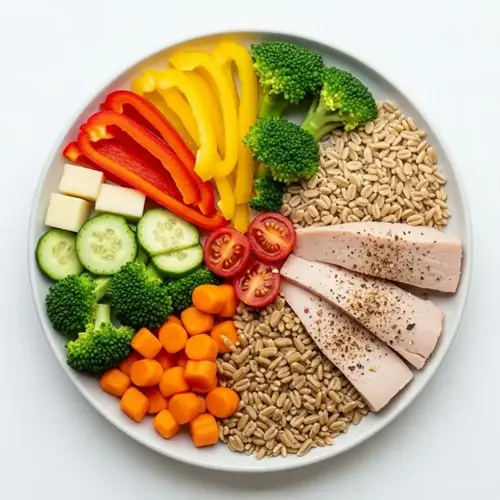Sodium Potassium Balance: Essential Health Guide

Written by
Natalie Hamilton
Reviewed by
Prof. Benjamin Murphy, Ph.D.Balancing sodium and potassium can help regulate blood pressure and reduce cardiovascular disease risk.
Aim for an ideal sodium to potassium ratio of 1:3 for beneficial effects on your whole body!
Also, those with kidney disease require restrictive potassium diets under medical supervision.
Try to eat potassium-packed whole foods every day instead of sodium-packed processed foods.
The synergy between electrolytes helps to facilitate nerve signal transmissions and muscle function efficiently.
Even small dietary changes will lead to significant long-term health benefits.
Article Navigation
Your body needs balance of sodium and potassium in order to function well. These minerals are electrolytes. They help your nerves send messages. They help your muscles contract. They help control your fluids. Without this balance, you feel weak and tired.
Most of us are getting too much sodium. About 90% of us eat more sodium than we should. Less than 10% of us get enough potassium. This imbalance is the cause of various problems. It raises blood pressure. It strains the heart. It injures the kidneys over time.
You can correct this imbalance. There should be a 1:3 sodium to potassium ratio. That means there should be three times as much potassium as sodium. This is protective for your heart. It helps your kidneys work better. It helps your body run well.
Special Population Considerations
Kidney disease alters everything about electrolyte control. If your kidneys are compromised, they can not remove excess potassium. It builds up to dangerous levels called hyperkalemia. You need to work with your doctor to limit your potassium intake. Never self-adjust your supplements or foods.
Medications directly influence your sodium-potassium balance. ACE inhibitors make you hold potassium. Diuretics cause you to discard potassium. Both need careful monitoring. I have seen patients get dizzy when their medications changed their electrolyte levels without notice.
With age, the kidneys gradually lose their ability to filter. Elderly people are thus especially prone to imbalances. Simple dehydration can easily cause serious trouble. Older adults should have their sodium (Na) and potassium (K) levels checked twice a year. Prevention is more important as the function of the kidneys is normally impaired.
Hypertension requires certain control over sodium. Limit intake to no more than 1,500mg a day. That is only 0.05 ounces of salt. This comes first before adding more potassium. Reducing sodium will give quicker results in blood pressure control than just adding potassium.
Hydration and Electrolyte Synergy
Water and electrolytes are like two friends who work together in harmony. Sodium levels rise when dehydrated because there is less fluid available. Kidneys try to hold onto fluids. This raises blood pressure. When over-hydrated, they dilute electrolytes to dangerously low levels.
Drink 7 to 8 glasses of water daily and incorporate fluids rich in potassium, such as coconut water or milk. This maintains the balance that your cells need. This I learned when I was training for a marathon. Proper hydration eliminated the muscle cramps.
Electrolyte balance is crucial for the health of your nerves and muscles. Sodium and potassium create electrical impulses. These impulses control every movement and feeling in the body. Electric impulses are stopped when there is an electrolyte imbalance. You may experience tingling or muscle weakness. Chemical balance must be maintained for efficient function.
Dehydration Effects
- Impact: Reduces blood volume, concentrating sodium and increasing blood pressure
- Consequence: Triggers kidney conservation of water, worsening potassium imbalance
- Symptom: Dark urine, fatigue, dizziness indicate dehydration requiring immediate action
Overhydration Risks
- Process: Excess water dilutes sodium (hyponatremia), causing cells to swell
- Effect: Impairs nerve/muscle function, leading to headaches and confusion
- Prevention: Balance water intake with electrolyte consumption during prolonged activity
Fluid-Electrolyte Synergy
- Mechanism: Sodium/potassium pumps regulate fluid movement between cells
- Function: Maintain blood pressure, nerve signals, and muscle contractions
- Co-factors: Magnesium aids potassium absorption; calcium regulates muscle contractions
Potassium-Rich Hydration
- Sources: Coconut water, milk, and low-sodium vegetable juices
- Benefit: Provide potassium without excess sodium, supporting 1:3 ratio
- Daily: Replace 1-2 water glasses with potassium fluids for balance
Activity Adjustments
- Exercise: Sweat loss requires extra 16-24 oz (473-710 ml) water hourly
- Electrolytes: Add 300-600 mg sodium and 200-400 mg potassium per liter
- Recovery: Consume potassium-rich foods within 30 minutes post-activity
Ideal Sodium Potassium Ratio
The optimum sodium potassium ratio is 1:3. In other words one part sodium to three parts potassium. The balance is more important than the actual amounts of individual minerals. For example if 1,500mg sodium is required then 4,500mg potassium is necessary. To get your ratio divide your sodium intake by the potassium intake.
Most Americans have a dangerous ratio of 1.41. Too much sodium from processed foods. Too little potassium from vegetables. This ratio puts a strain on the heart. It drives up blood pressure. Most of my patients are shocked to find that their ratio explains chronic health problems.
"Adjusting your ratio is more important than reducing salt on its own. Potassium relaxes blood vessels, and sodium contracts them. The two yield the proper ratio for fluid balance. When you think of sodium, potassium, or chloride, think ratios, not just numbers. Your heart and kidneys will appreciate the difference."
Optimal Ratio Definition
- Target: 1 part sodium to 3 parts potassium (1:3 ratio)
- Calculation: Sodium intake (mg) ÷ Potassium intake (mg) ≤ 0.33
- Example: 1,500 mg sodium requires 4,500 mg potassium
- Pediatric Context: Children naturally maintain ratios below 1
Current Average Status
- US Adults: Average ratio of 1.41 (sodium-dominant)
- Cause: High processed food consumption (75% of sodium intake)
- Impact: Contributes to elevated systolic blood pressure
- Children: Ratios increase with age due to dietary shifts
Health Impact Evidence
- Blood Pressure: 10% lower ratio correlates with 3 mmHg systolic reduction
- Cardiovascular Risk: 0.5 higher ratio increases heart disease risk by 25%
- Mortality: Higher ratios associated with increased all-cause mortality
Ratio Improvement Strategies
- Sodium Reduction: Limit to 1,500-2,300 mg/day depending on health status
- Potassium Boost: Consume 4,700 mg/day from vegetables, fruits, legumes
- Food Swaps: Replace processed snacks with fresh produce
Special Population Ratios
- Children: Naturally lower ratios (<1) that increase with age
- Hypertensive Patients: Require stricter 1:4 ratios (≤0.25)
- Black Populations: More responsive to ratio improvements
Top Food Sources and Strategies
Instead of processed foods, replace them with "potassium-rich whole foods." A fast-food burger contains about 1,000 mg of sodium. A baked potato contains about 900mg of potassium. Choose one cup of spinach (30g) instead of canned soup. This simple swap will ensure the electrolyte changes happen immediately.
Use smarter cooking for increased potassium. Steam veggies rather than boil them. Roast sweet potatoes instead of frying them. Use herbs instead of salt. I roast three cups of vegetables a week. This preserves potassium while reducing sodium intake by half.
Read all labels with care. Check the sodium per serving. Compare brands. Buy products marked 'low sodium,' which means they contain under 140 milligrams of sodium. Look for hidden sodium in bread and sauces. This will save you 500 milligrams extra a day.
Measure portions precisely. One medium banana (118g) provides approximately 10% of the recommended daily intake of potassium. Use 1 ounce (28g) of unsalted nuts for snacks. Drink eight ounces of coconut water (237ml). These precise amounts help maintain your ideal electrolyte ratio consistently.
Vegetable Preparation
- Steaming: Preserves 90% potassium vs boiling's 60% retention
- Roasting: Concentrates flavor without adding sodium
- Raw: Maximizes potassium in salads and smoothies
Smart Substitutions
- Salt swaps: Use potassium chloride salt substitute (consult doctor)
- Broth alternative: Replace salt with mushroom powder (high in potassium)
- Baking trick: Substitute 1/4 baking soda with potassium bicarbonate
Label Reading
- Check servings: Sodium content often listed per 1/2 cup (118ml) not full container
- Look for claims: 'Low sodium' = ≤140mg/serving (5% DV)
- Compare brands: Soups vary up to 840mg/serving between brands
Meal Planning
- Breakfast: Swap bacon for avocado toast (banana + whole grain)
- Lunch: Choose fresh turkey over processed deli meats
- Dinner: Roast potatoes with herbs instead of salted fries
Dining Out Tips
- Request: Sauces/dressings on side to control sodium
- Avoid: Breaded/fried items which absorb more salt
- Choose: Grilled fish with steamed vegetables instead of sauced dishes
Top Potassium Sources
- Bananas: 1 medium (118g) = 422mg potassium
- Spinach: 1 cup (30g raw) = 167mg potassium
- Sweet potatoes: 1 medium (114g) = 542mg potassium
- Beans: 1/2 cup (90g cooked) = 400-600mg potassium
Why Sodium Potassium Balance Matters
Your blood pressure is directly correlated with sodium potassium balance. Sodium causes your cells to hold water, increasing the pressure in the vessels. Potassium relaxes the walls of the blood vessels, improving blood flow. Together, they regulate your cardiovascular system better than either mineral can alone.
Kidney stones are formed when an acid accumulates in the kidneys. Potassium citrate neutralizes this acid, preventing the formation of crystals. I've had patients cut their recurrence of stones in half just by eating potassium-rich foods like bananas and oranges regularly.
Strong bones rely on calcium. Sodium causes the loss of calcium through urine. Potassium prevents calcium loss by balancing the acids. Maintain the proper ratio of sodium and potassium. You'll keep your bones strong and full of calcium, providing the necessary prevention from osteoporosis, specifically after menopause.
The risk of heart disease declines dramatically with balanced electrolytes. The 1:3 ratio reduces arterial stiffness. It prevents plaque formation. It keeps the blood thin and flowing. This protection is more important than cholesterol levels alone.
Blood Pressure Regulation
- Sodium effect: Increases fluid retention → higher blood volume → elevated pressure
- Potassium counteraction: Relaxes blood vessel walls → improves blood flow → lowers pressure
- Research finding: 1.41 ratio correlates with 5-7 mmHg higher systolic pressure
Cardiovascular Protection
- Stroke risk: Reduction with optimal ratio
- Heart disease: Lower incidence at 1:3 ratio
- Mortality: Decrease with ratio improvement
Kidney Health
- Stone prevention: Potassium citrate reduces urinary calcium excretion
- Function support: Maintains acid-base balance crucial for filtration
- Risk reduction: Lower kidney stone incidence at sufficient potassium
Bone Integrity
- Calcium preservation: Potassium bicarbonate buffers metabolic acids
- Mineral retention: Reduces bone resorption
- Osteoporosis link: Low potassium diets correlate with higher fracture rates
Muscle and Nerve Function
- Electrolyte synergy: Sodium-potassium pump enables cellular communication
- Deficiency risks: Imbalance causes cramps, weakness, or arrhythmias
- Optimal performance: Required ratio ensures efficient contraction-relaxation cycles
5 Common Myths
Sea salt contains less sodium than regular table salt and is better for blood pressure control.
Sea salt and table salt each contain about 40% sodium by weight, so they each have the same effect on blood pressure if used in the same quantities. The minor mineral differences in sea salt result in no great benefits for health. The difference between salt and sea salt is primarily one of texture and taste, not of sodium minimization, so it is no better for health if the intake of sodium is being limited.
Potassium supplementation is always safe and effective for replacement of electrolyte imbalances in all individuals.
Potassium supplementation can lead to lethal hyperkalemia in individuals with renal disease or those taking drugs like ACE inhibitors. This condition can lead to fatal and life threatening cardiac arrhythmias with no warning symptoms. Always have supplementation approved by health care providers, since whole food sources of potassium are safer for all individuals and can additionally provide extra nutrients without overdosing problems.
The sensation of thirst indicates the immediate need for water and electrolytes within your body to avoid imbalance.
The feeling of thirst comes only after the body's electrolyte balance starts to affect blood osmolarity. By the time thirst is felt, sodium levels in the blood are up, which can lead to an early stage of dehydration. This is why proactive hydration with a balanced electrolyte intake is needed during activity or heat exposure, since thirst is a lagging indicator, not a preventative indicator.
Processed foods should not be completely avoided because they are all equally as high in sodium.
Sodium content can vary tremendously per food in this category. Some processed foods of certain brands are low sodium foods, containing as much as 70% less sodium than typical foods. A comparison of the nutritional information in these labels shows a great variety, i.e., tinned soups range from 100mg. to 940mg. of sodium per serving. By making judicious choices it is possible to reduce sodium intake without eliminating sodium entirely. It is thus important to buy processed foods which make the claim of being low in sodium.
Eating high-potassium foods automatically counteracts all negative effects of high sodium consumption.
Potassium only partially mitigates sodium's effects unless consumed in the precise 1:3 ratio (e.g., 1,500mg sodium requires 4,500mg potassium). Even potassium-rich meals fail to balance excessive sodium from processed foods due to absorption kinetics. Achieving full cardiovascular protection requires intentional ratio management, not just occasional high-potassium food consumption.
Conclusion
Your body's sodium potassium balance facilitates every major system. From your heart pumping blood to your brain sending off signals. This partnership of electrolytes keeps you alive and functioning at peak levels. Ignoring it puts you at risk of simultaneously interrupting multiple systems.
To achieve the 1:3 ratio requires daily input. Track your sodium and potassium consumption daily. Review every nutrition label carefully. Select whole foods carefully. This awareness quickly becomes second nature, just like my morning beverage hydration habit.
Small changes can have a big effect over time. Swap one processed snack daily for a banana. Use herbs instead of salt. When you make these small changes daily, you create a gradual improvement in your ratio and prevent chronic disease without significantly altering your lifestyle.
Always consult your doctor before making any dietary changes. Kidney patients need potassium restrictions. Those on blood pressure medications require monitoring. Your provider personalizes electrolyte targets for your unique biology.
External Sources
Frequently Asked Questions
How does sodium potassium balance affect blood pressure?
Sodium increases fluid retention, raising blood volume and pressure, while potassium relaxes blood vessels to improve flow. Maintaining the ideal 1:3 ratio prevents hypertension by counteracting sodium's effects and supporting cardiovascular health through complementary physiological mechanisms.
What's the optimal sodium to potassium ratio?
The scientifically recommended ratio is 1 part sodium to 3 parts potassium. For example, consuming 1,500mg sodium requires 4,500mg potassium. This balance optimizes nerve function, muscle contractions, and fluid regulation while minimizing cardiovascular risks associated with sodium-dominant diets.
What are symptoms of electrolyte imbalance?
Key indicators include:
- Muscle cramps or weakness from potassium deficiency
- Fatigue and confusion due to sodium depletion
- Irregular heartbeat signaling severe potassium imbalance
- Headaches or dizziness from dehydration effects
Which foods improve potassium intake naturally?
Prioritize these potassium-rich whole foods:
- Leafy greens like spinach and kale
- Fruits including bananas, oranges, and avocados
- Legumes such as lentils and kidney beans
- Root vegetables like potatoes and sweet potatoes
How do kidneys process sodium and potassium?
Kidneys filter excess sodium and potassium while maintaining blood electrolyte balance. Impaired kidney function disrupts this regulation, potentially causing dangerous buildup of either mineral. Those with kidney disease require medical supervision to adjust intake and prevent life-threatening complications.
Can potassium supplements replace dietary sources?
Potassium supplements pose risks like hyperkalemia and should only be used under medical supervision. Whole-food sources provide safer, balanced nutrition with additional vitamins and fiber. Supplements lack the synergistic benefits of natural food matrices for optimal absorption.
Why is thirst a poor hydration indicator?
Thirst signals appear only after electrolyte imbalance begins, making them reactive rather than preventive. Proactive hydration with balanced electrolytes is essential during activity or heat, as delayed thirst response allows early-stage dehydration and sodium concentration spikes.
How does sodium potassium balance affect bones?
Potassium buffers metabolic acids that leach calcium from bones, while excess sodium increases calcium excretion. Maintaining proper ratios reduces bone resorption by significant percentages, directly lowering osteoporosis risk and supporting long-term skeletal integrity.
Do sea salt and table salt differ nutritionally?
Both contain identical sodium content and affect blood pressure comparably. Mineral variations in sea salt offer negligible health benefits. Choosing between them primarily influences taste and texture, not sodium reduction or cardiovascular protection.
How quickly does electrolyte balance improve health?
Noticeable benefits like reduced bloating and stabilized energy occur within weeks. Long-term cardiovascular and blood pressure improvements manifest over several months of consistent dietary adjustments. Sustained electrolyte management yields cumulative protective effects against chronic diseases.

